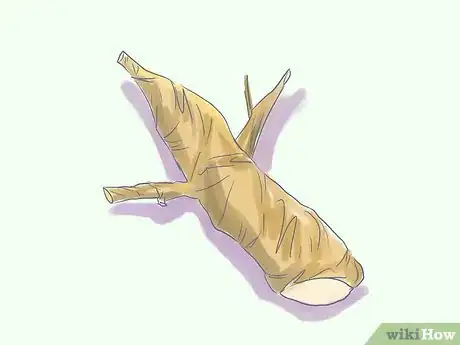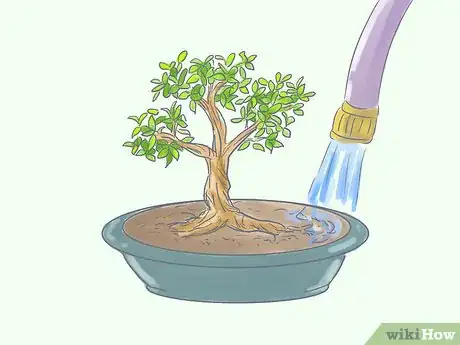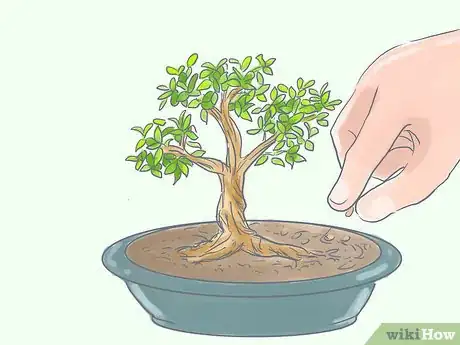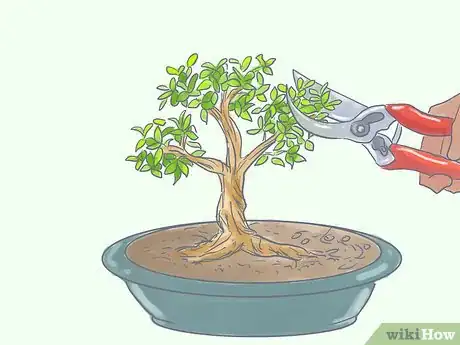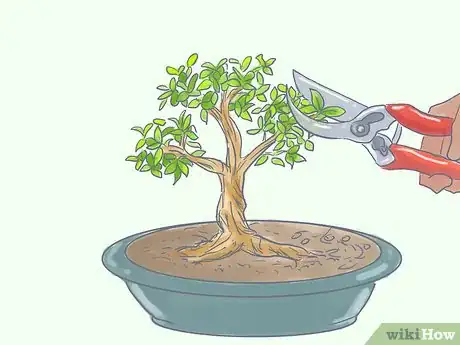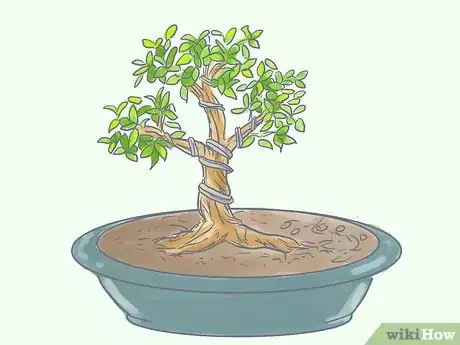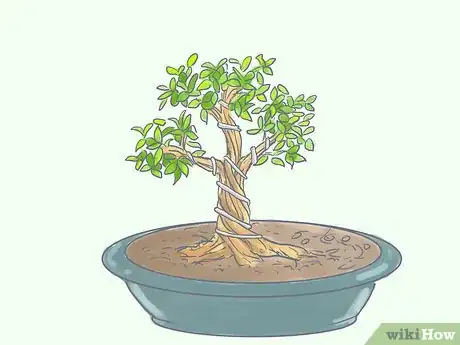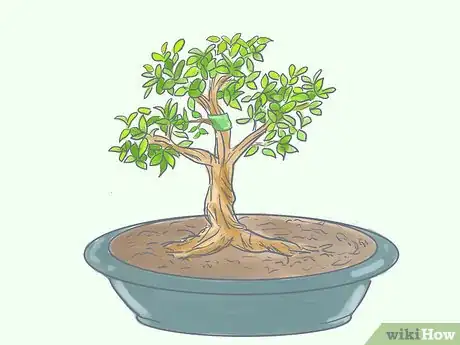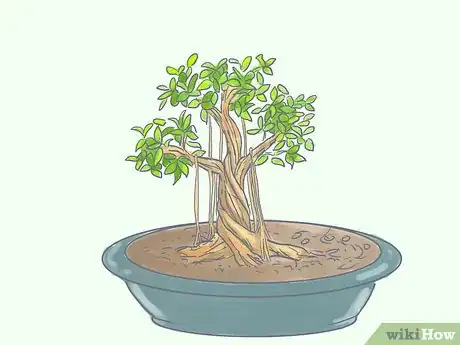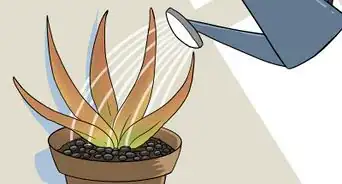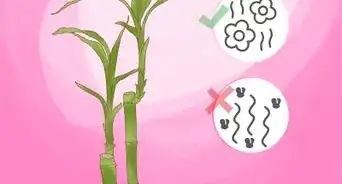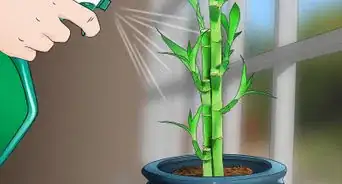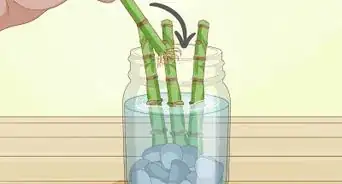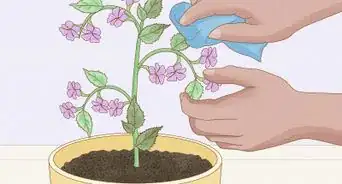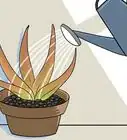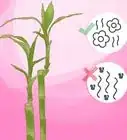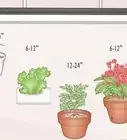This article was co-authored by Melinda Meservy. Melinda Meservy is a Plant Specialist and the Owner of Thyme and Place, a botanical boutique offering plants and gifts in Salt Lake City, Utah. Before starting her own business, Melinda worked in process and business improvement and data analytics. Melinda earned a BA in History from the University of Utah, is trained in lean and agile methodologies, and completed her Certified Professional Facilitator certification. Thyme and Place offers indoor plants and containers, a fully stocked potting bench, and tips on plants to suit your space and lifestyle.
wikiHow marks an article as reader-approved once it receives enough positive feedback. In this case, several readers have written to tell us that this article was helpful to them, earning it our reader-approved status.
This article has been viewed 43,111 times.
The tiger bark ficus bonsai tree is an indoor tree that needs to be kept away from frost.
Steps
Propagation
-
1Plant a cutting. Cuttings can be planted at any time of the year, but the highest success is likely to be experienced with mid-summer growth.
- Airlayering will work best in spring (April – May).
-
2Grow from seed. Growing ficus plants from seed in spring also works easily in most cases.Advertisement
-
3Purchase ficus ginseng bonsai as an already growing plant. Ficus plants are available as cheap bonsai or pot plants in nearly every home-store, building supplies store or nursery.
- Be aware that mass-produced cheap bonsai in most cases bring a lot of problems with them, like ugly scars from rusty wire that bit into the bark, unattractive shapes, often poorly grafted branches in odd positions, bad soil and sometimes inappropriate pots without drainage holes. On the other hand, specialised bonsai traders offer everything from young plants, pre-bonsai and pre-styled ficus trees up to high-value bonsai, in most cases well-tended and of good quality.
Providing an appropriate position
-
1Grow the plant indoors. The ficus bonsai tree is an indoor bonsai which cannot endure frost. It can be kept outside in summer, if temperatures are above 15 degrees C (59ºF).
-
2Ensure plenty of light. This plant needs lots of light. Full sun is ideal, in the house as well as outside. A very shady position is unfavourable.
- If the tree is outside, expose it to the ultraviolet radiation gradually or make sure it is defoliated before placing the tree outside.
-
3Keep the temperature relatively constant. Figs can endure low humidity due to their thick, waxy leaves, but they prefer a higher humidity and need extremely high humidity to develop aerial roots.
Pruning
-
1Prune often. Regular pruning is necessary to retain the tree’s shape.
-
2Prune back to two leaves after six to eight leaves have grown.
- Leaf pruning can be used to reduce leaf size, as some ficus bonsai species normally grow large leaves.
- If a considerable thickening of the trunk is desired, the ficus can be left to grow freely for one or two years. The strong cuts that are necessary afterwards don't affect the ficus' health and new shoots will grow from old wood.
- Larger wounds should be covered with cut paste.
Wiring
-
1Wire the branches. Wiring of thin to medium-strong ficus branches is easy as they are very flexible. The wires should be checked regularly though, as they cut into the bark very quickly. Strong branches should be shaped with guy-wires because those can be left on the tree for a much longer period.
-
2Try some special training techniques:
- Ficus has the ability to fuse plant parts which touch each other with some pressure. So branches, roots or trunks can fuse together and form appealing structures. You can use this feature for example to tie a lot of young plants together and let them fuse to build one strong single trunk.
- Fig trees also react very well to approach-grafting of branches and roots and to other grafting techniques. If the growing conditions are ideal, even aerial roots taken from one part of the tree can be grafted in a different position.
-
3For faster closing of large wounds young plants, shoots or aerial roots can be grafted across the wound. The grower can work on fig trees with nearly unlimited creativity, which increases the appeal of ficus as a bonsai plant considerably.
-
4Use the roots as part of the designing. Most ficus bonsai trees can produce aerial roots in their natural habitat, which are often presented in appealing bonsai creations with many aerial root pillars or root over rock styles. To enable aerial root growth in your home, a humidity of nearly 100% must be achieved artificially. You can use a glass cover, fish tank or a construction with transparent sheets for this purpose.
- Aerial roots grow down vertically from the branches and when they reach the soil they develop into strong pillar-like trunks.
Community Q&A
-
QuestionDo they lose leaves in the fall and come back in the spring?
 Community AnswerFigs are evergreen, not deciduous. So they will keep their leaves all year round. If your ficus is losing leaves it could be due to stress.
Community AnswerFigs are evergreen, not deciduous. So they will keep their leaves all year round. If your ficus is losing leaves it could be due to stress.
Warnings
- Ficus Ginseng Bonsai plants are poisonous for pets, it can be especially dangerous if they eat the leaves. The trees should be placed out of the pets' reach.⧼thumbs_response⧽
- Pests / diseases: The fig species are quite resistant against pests. Depending on the location, especially in winter, a number of problems can occur anyway. Dry air and a lack of light weaken the bonsai ficus and often result in leaf drop. In a poor condition like this, ficus bonsai are sometimes infested with scale or spider mites. Customary systemic insecticide sticks to put into the soil or insecticide/miticide sprays will work, but the weakened ficus' living conditions must also be improved. Plant lamps (shining 12 – 14 hours a day) and frequent misting of the leaves during the recovery can be helpful.⧼thumbs_response⧽
